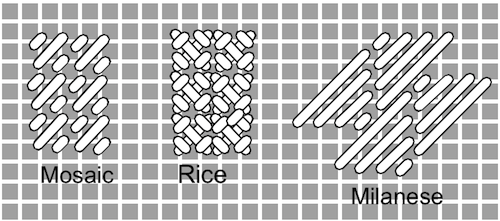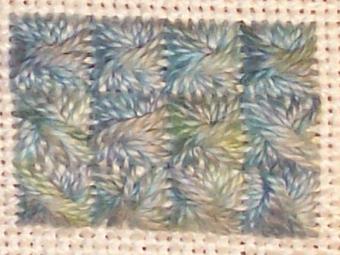- Home
- Needlepoint
- Needlepoint Stitches
Choosing needlepoint stitches for your projects
Choosing the right needlepoint stitch can feel overwhelming at first—there are so many options!
But don’t worry, you don’t need to learn them all at once.
Whether you’re just starting or looking to improve, the key is knowing a few essential stitches and understanding how they affect your design.
Think of needlepoint like painting with thread.
- Some stitches create smooth backgrounds, while others add texture and depth.
- Some are quick and easy, while others take more time but give stunning effects.
The good news?
With just a few simple techniques, you can create beautiful, polished needlepoint designs that look professional—even as a beginner.
✂️ Start Here: The 3 Most Beginner-Friendly Stitches
Before trying out all the options, here are three stitches every beginner should master first:
Tent Stitch – The foundation of most needlepoint projects. Quick, smooth, and perfect for beginners.
Rice Stitch – Also known as Crossed Corners which describes it well.
Gobelin Stitch – A versatile stitch that can be short or long, perfect for shading.
As you continue learning, you’ll discover more stitches that add dimension and personality to your work.
In this guide, I’ll walk you through how to choose the right stitch for your design, when to use different types, and how to avoid common mistakes.
Ready to stitch with confidence? Let’s get started!

The Importance of Stitch Direction
Each needlepoint stitch has a natural direction—some are always worked diagonally, while others follow straight horizontal or vertical lines.
While you can’t change the way a stitch is worked, you can choose the best stitch for the effect you want.
Why Stitch Direction Matters
Stitch direction determines how your design looks and how your canvas behaves:
- Diagonal stitches distribute thread tension differently from straight stitches, sometimes causing the canvas to distort.
- The direction of the stitch can create a visual effect—some stitches appear smooth and subtle, while others add strong lines or movement to the design.
Choosing the Right Stitch for the Right Effect
When selecting a stitch, think about the effect you want to achieve:
- Want to create a sense of movement? Choose a stitch that naturally flows in the direction you want, like Slanted Gobelin for sloping hills.
- Need stability and structure? Use a straight-aligned stitch like Brick Stitch for buildings and borders.
For example, if you're stitching a tree, you might use an upright Gobelin for the trunk (to give it a strong, structured look) and a Diagonal Mosaic Stitch for the leaves (to create movement).
If you're stitching a brick wall, horizontal stitches will help create a more realistic effect.
Pro Tip: Preventing Canvas Warping
Diagonal stitches can sometimes pull fabric out of shape. Using a frame or stretcher bars will help keep the canvas even and prevent distortion.
Stitches Without a Visible Direction
Not all stitches create strong lines or obvious movement.
Some blend smoothly into the design, making them ideal for backgrounds or areas where you want texture without a dominant direction.
- Textured stitches (like Rice Stitch or Rhodes) add visual interest without guiding the eye in a particular direction.
- Even-coverage stitches (like Tent Stitch) create a balanced, uniform look, making them perfect for background areas where you don’t want the stitches to compete with the main design.
If your design needs a soft, blended effect, consider a stitch that adds depth without a strong directional pull. This keeps the focus on your main elements while adding richness and dimension to your work.
Stitch Size: Why It Matters
The size of your stitches affects how your design looks, how much detail you can include, and how your canvas behaves.
Some stitches are tiny and delicate, while others are large and bold.
Choosing the right size helps balance your design.
Choosing the Right Stitch Size for Your Design

Size of the Area → Larger stitches (like Milanese Stitch) cover more area quickly and create bold, textured effects. These are great for backgrounds, decorative borders, and filling large spaces.
Level of Detail Needed - Smaller stitches (like Mosaic Stitch) offer more precision and detail. They work well for fine details, small design elements, and intricate patterns.
Thread Coverage and Texture → Large stitches often create more raised, textured surfaces, while smaller stitches provide a smoother finish.
Combination stitches—many needlepoint stitches are made up of multiple individual stitches grouped together. The total size of the group determines the overall impact on your design.
Pro Tip: Balancing Stitch Size in a Design
Mixing stitch sizes within a piece helps create depth and contrast.
Use larger stitches for backgrounds or bold elements and smaller stitches for detailed areas to keep your design visually balanced.
Now that you understand how stitch size affects your work, let’s explore how stitch shape influences your final design!
Overall Shape of a Group of Stitches
While individual stitches have a set structure, many needlepoint stitches are grouped together to form larger patterns.
The overall shape these groups create affects how your design looks and how smoothly it fits into the stitched area.
Common Stitch Group Shapes & Their Effects
Square or Rectangular Stitches (e.g., Scotch Stitch, Chequer Stitch)
- Create a structured, geometric look.
- Great for backgrounds, tiled patterns, and architectural elements.
- Can leave small gaps at the edges of irregular shapes, requiring compensating stitches.

Diagonal & Slanted Stitches (e.g., Slanted Gobelin, Diagonal Mosaic)
- Add movement and a sense of flow to designs.
- Work well for natural elements like waves, grass, or fabric folds.
- May pull the fabric more than straight stitches—using a frame helps prevent distortion.
Irregular Stitches (e.g., Leaf Stitch, Rhodes Stitch)
- Break away from straight lines to create softer, organic shapes.
- Perfect for floral designs, foliage, and rounded objects.
- Can be trickier to fit into grid-based designs but add beautiful texture and depth.
Working with Partial Shapes and Edges
Not every stitch will perfectly fit an area of your design.
Sometimes, you’ll need compensating stitches to fill smaller spaces at the edges of a design.
These are portions of a larger stitch that are adjusted to fit into the available area—helping create a clean, polished finish.
Pro Tip: Using Stitch Shape to Enhance Your Design
If you want your piece to look structured and orderly, stick to stitches with square or rectangular formations.
If you want a more natural, free-flowing effect, incorporate diagonal or curved stitch groupings.
Mixing both can create contrast and visual interest!
The Texture a Stitch Creates
Texture plays a huge role in needlepoint—it adds dimension, contrast, and personality to your design.
Some stitches create a smooth, even surface, while others stand out with raised or bumpy textures.
Choosing the right texture helps bring your project to life!

Different Types of Needlepoint Textures
Flat and Smooth Stitches (e.g., Tent Stitch, Continental Stitch)
- Create an even, polished look.
- Ideal for backgrounds or areas where you want colors to blend seamlessly.
- Great for fine details because they don’t add extra height or bulk.
Raised and Dimensional Stitches (e.g., Rhodes Stitch, Smyrna Cross)
- Stand out from the fabric, adding depth and interest.
- Perfect for bold design elements like flower centers, decorative accents, or focal points.
- Work well when combined with smoother stitches for contrast.
Textured and Patterned Stitches (e.g., Hungarian Stitch, Bargello)
- Create subtle patterns or ridges that give movement to the design.
- Excellent for clothing details, landscapes, or textured surfaces like fur or water.
- Provide an interesting visual effect without being overly raised.
Pile and Loop Stitches (e.g., Velvet Stitch, Turkey Work)
- Form a plush, fabric-like effect.
- Great for fur, hair, or areas where a soft, tactile surface is needed.
- Can be trimmed for a smooth finish or left looped for a shaggy effect.
How to Use Texture Effectively
When planning your project, think about which areas should be smooth, which should stand out, and how texture can enhance the final look:
- Want to highlight an element? Use raised or looped stitches to make it pop.
- Need a soft, blended background? Stick to smooth, flat stitches.
- Looking for variety? Mix textures to create contrast and depth.
For example, if you’re stitching a landscape, you might use Gobelin for rolling hills, Tent Stitch for the sky, and Velvet Stitch for fluffy clouds or a furry animal.
Pro Tip: Balancing Texture in a Design
Too much texture can make a piece look busy or uneven.
Try combining smooth areas with raised details to create a design that feels polished and visually appealing.
Build Your Needlepoint Stitch Library
Having a go-to collection of stitches makes needlepoint more enjoyable and helps you quickly choose the right stitch for any project.
Below, you'll find some essential stitches categorized by their purpose and effect.
Foundation Stitches (Great for Beginners!)
These stitches form the backbone of most needlepoint projects and provide a smooth, even coverage.
🪡 Tent Stitch – The most versatile stitch, perfect for backgrounds and fine details.
🪡 Basketweave Stitch – Prevents canvas distortion, ideal for large areas.
🪡 Gobelin Stitch – Covers more ground with longer stitches, great for shading.
Decorative and Textured Stitches
Use these stitches to add depth, interest, and personality to your work.
🎨 Scotch Stitch – Creates a structured, geometric pattern.
🎨 Rhodes Stitch – A raised, spiral effect perfect for accents.
🎨 Rice Stitch – Adds texture with layered cross-stitches.
Organic and Free-Flowing Stitches
Perfect for natural shapes, foliage, or soft textures in your design.
🍃 Leaf Stitch – Creates realistic leaves and natural forms.
🍃 Velvet Stitch – Adds plush, raised texture for fur or soft surfaces.
🍃 Diagonal Mosaic Stitch – A slanted stitch that adds movement and variety.
Ready to Start Stitching?
Now that you understand how stitch direction, size, shape, and texture affect your design, it’s time to put your knowledge into practice!
Whether you're working on your first project or refining your technique, experimenting with different stitches is the best way to build confidence and skill.
Have a favorite stitch or a project you’re proud of?
I’d love to see your work! Share your progress, or ask questions in the feedback section below. Let’s keep learning and stitching together!
Stay connected between projects
If you’d like occasional updates from my embroidery room, including new patterns, gentle tips, and little things I think you might enjoy, you’re warmly invited to join the Stitchin’ Times newsletter.
No pressure. Just a friendly note now and then to keep you inspired.


